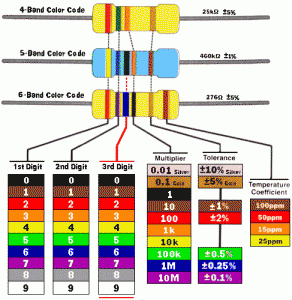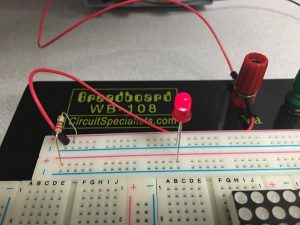Resistor Color Codes Guide
Resistor color codes can be a tricky thing. Knowing what resistor color codes equate to particular resistance values can mean saving hundreds of dollars! Many of our resistors on our site sell for $0.10 or less so you can imagine how inexpensive a single resistor replacement can be with the right tools as compared to replacing an entire printed circuit board assembly.
For even more assistance determining resistance from the resistor color code then take a look at our handy Resistor Color Calculator that will link you directly to the corresponding resistor item pages if available.
If you’re looking for discounted electronic components then check out our new Stock Clearance page where items are as much as 90% off MSRP.
Sometimes, discerning the colors on a burnt-up resistor can be a tricky thing. One thing to keep in mind is that you should always remove a resistor from the board prior to measuring its resistance with your multimeter, if you are unsure of the value. The reason for this is that you want to make sure there is only one path between the leads of your meter and that being across the resistor, if you are measuring on an unfamiliar board there may be traces that lead to other paths of non-infinite resistance between the legs, skewing the actual measured value.
A helpful, commonly used guide can be found below. As you’ll see you may encounter resistors with 4-bands, 5-bands, and 6-bands. Keep in mind the colors and corresponding numeric values don’t change between these resistors, all that changes is the position of the multiplier and tolerance.

Memorizing these resistor color codes can be a tricky thing. One useful trick that you may have practiced using in school is coming up with a mnemonic to help. One of our favorite mnemonics, inspired by the Russians, that interprets the color code chart to a phrase is:
(0) Bad (1) Beer (2) Rots (3) Our (4) Young (5) Guts (6) But (7) Vodka (8) Goes (9) Well
0-Black
1-Brown
2-Red
3-Orange
4-Yellow
5-Green
6-Blue
7-Violet
8-Grey
9-White
While not electronically themed, the mnemonic definitely made it easier for us at Circuit Specialists to memorize the resistor color codes. One thing to keep in mind is that the mnemonic applies only to the first few bands of the resistors, the last two bands are always the multiplier (2nd to last) and tolerance (last). Make sure to use the image above to determine what colors correspond to which values and not to rely on the mnemonic. We hope you found this article helpful and take a look at our electronics component clearance page if you want to shop resistors or other components.



